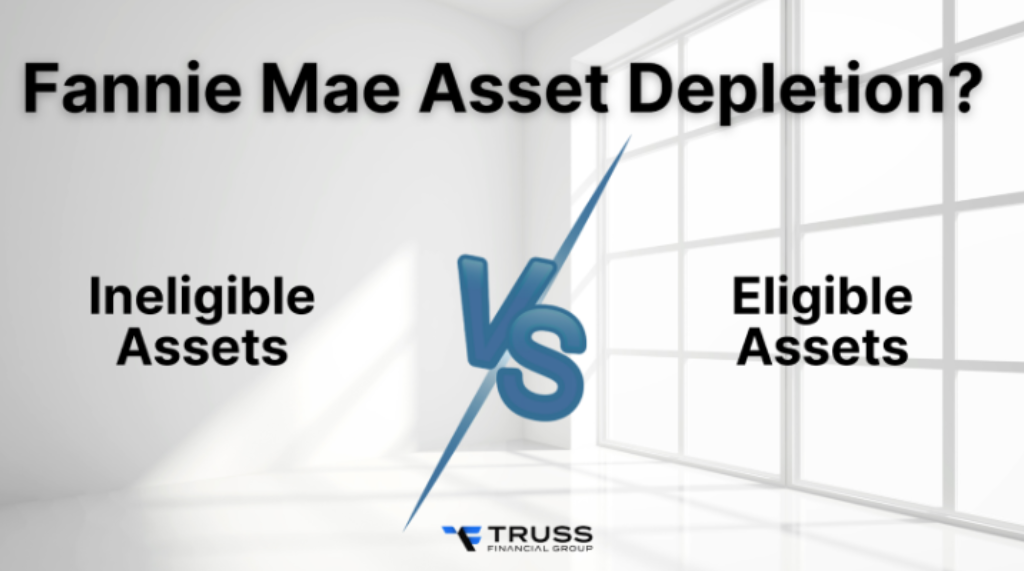11 min read

If you’ve been searching for Fannie Mae asset depletion guidelines, you’ve probably seen a lot of confusing jargon.
We’ll walk through eligible vs ineligible assets under Fannie Mae’s Employment-Related Assets as Qualifying Income, show you exactly how to calculate asset depletion income, explain the Age-62 rule and LTV caps, and highlight the difference between Fannie Mae vs Freddie Mac asset depletion.
We’ll also cover what counts (retirement accounts with access, employer lump sums) and what doesn’t (unsourced checking, crypto, unvested RSUs). If you’re exploring asset depletion mortgage alternatives, such as Non-QM or DSCR loans, we’ll link you to those options as well, so you have the full picture in one place.
What are Eligible Assets Under Fannie Mae's Rule?
Under Fannie Mae’s rule, “eligible assets” for asset-depletion income come from employment-related sources only. In practice, that’s two buckets:
1. Retirement Accounts with Access (401(k), IRA, SEP, Keogh)
You must have the unqualified, unlimited right to request a distribution of all funds as of the time of calculation. Tax withholding or possible penalties don’t negate “access”; they’re just deductions in the math.
If a distribution would trigger a penalty today (e.g., under 59½), subtract that amount first. Then subtract funds for down payment, closing costs, and required reserves. The remainder is your Net Documented Assets.
Fannie Mae’s table defines it explicitly and even provides a calculation example.
2. Employment-Related Lump Sums & Severance (Documented)
Allowed when you document the payout (for example, an employer/plan letter or 1099-R) and show the deposit to a verifiable account.
You still apply the same “netting” steps: subtract any penalty that would apply today and transaction funds (down payment/closing/reserves) before turning the balance into monthly income.
3. Penalty Handling (if Distributed Today)
Fannie Mae’s calculation frames it as:
Net Documented Assets = eligible employment-related assets – (penalty if a full distribution happened today) – funds for down payment/closing/reserves.

Monthly qualifying income = Net Documented Assets ÷ amortization term (months) (e.g., 360 for a 30-year, 300 for a 25-year).
Quick policy notes you can keep inline:
- Ineligible assets include non-employment-related sources (unvested RSUs/options, lawsuits, lottery, real-estate sale proceeds, inheritance). Checking/savings are generally not eligible unless the source of that balance was an eligible employment-related payout. Virtual currency (crypto) is not eligible.
- Age-62/LTV rule: Max LTV/CLTV/HCLTV is 70%, or 80% if the asset owner using this income is ≥62 at closing and all co-owners of the assets are co-borrowers. Scope: purchase or limited cash-out; primary or second home only.
What are Ineligible or Restricted Assets Under Fannie Mae?
Not every pile of money counts for Fannie Mae’s asset-depletion math. If it’s not employment-related or you don’t have unrestricted access, assume it’s out.
Here’s what that means in plain English.

1. Ordinary Checking/Savings (Unless Sourced from Eligible Lump Sum)
By themselves, cash balances don’t qualify as “employment-related assets.”
They can count only if you can prove the money came from an eligible employment-related source (e.g., severance or a documented lump-sum retirement distribution) with a clean deposit trail.
2. Unvested RSUs/Stock Options & ESPPs
If it’s unvested or restricted, you don’t have present, unrestricted access → it’s ineligible as employment-related assets for depletion.
Even for stock compensation generally, Fannie Mae is explicit: non-employment-related assets like stock options and non-vested restricted stock do not qualify for the employment-related assets method
3. Gifts, Inheritance, Lottery, Sale Proceeds
These are not employment-related. They can help with down payment/reserves, but they cannot be converted into monthly “income” under the employment-related assets rule. Fannie Mae lists lawsuits, lottery winnings, sale of real estate, inheritance, divorce proceeds as ineligible assets for this method.
4. Crypto / Highly Volatile Assets
Virtual currency (crypto) is not eligible, neither as income nor as acceptable assets for this income type. That’s straight from the guide.
Eligible vs Ineligible Assets: Comparison Table
|
Category |
Counts for Fannie Mae Asset Depletion? |
One-line rule |
|
401(k), IRA, SEP, Keogh with access |
Eligible |
Must have unrestricted access; subtract any penalty if distributed today; then subtract funds for down payment, closing, reserves. |
|
Employment-related lump sums (severance/pension) |
Eligible |
Must be documented (plan/employer docs, 1099-R) and deposited to a verifiable account. |
|
Ordinary checking/savings |
Not by default |
Only eligible if the balance came from an eligible employment-related lump sum (and the source is documented). |
|
Unvested RSUs/stock options/ESPP |
Ineligible |
No current, unrestricted access → excluded. |
|
Gifts, inheritance, lottery, sale proceeds, lawsuit |
Ineligible |
Not employment-related → can fund DP/reserves, but not depletion income. |
|
Crypto / virtual currency |
Ineligible |
Not allowed as income or qualifying assets. |
|
Assets moved into a new trust (≤12 months) |
Still eligible path |
If the source was eligible employment-related assets, you still use this method. |
Edge Cases & Timing
1. Assets Moved into a New Trust (≤12 Months)
Moved your retirement payout into a brand-new trust this year? That doesn’t magically change eligibility. If the source of funds was an employment-related payout (or a retirement account you can access), you still use the employment-related assets method. The title on the account changed; the math and documentation didn’t. Keep the paper trail tight (distribution letter/1099-R → bank/trust deposit)
2. Joint Ownership & Co-Borrower Requirement
Chasing the 80% LTV that kicks in at age 62+? Two must-haves:
- The person whose assets you’re using to qualify is 62+ at closing, and
- All owners of those assets are also borrowers on the loan. Miss either condition and you’re back to 70% LTV.
3. Second Home vs Investment Property
This income type is narrow by design:
- Allowed: Purchase or limited cash-out refi on a primary home or second home.
- Not allowed: Investment property for this income type.
Trying to force it for an investment property is a quick way to get a denial.
Worked Mini-Examples
1. 59½ with 10% Penalty
Stefan is 58. He’s retired early, big on index funds, light on pay stubs. His lender says, “We can’t count vibes, show us income.” So he reaches for Fannie Mae’s asset-depletion play.
He’s got $600,000 in a 401(k). Because he’s under 59½, a 10% penalty would apply if he took it now. Plus he needs $100,000 for down payment, closing, and reserves.
2. 62+ with No Co-Owners on the Loan (no penalty)
Christina is 64. She’s downsizing and pooling assets with her spouse. Total eligible, employment-related funds: $1,000,000. No early-withdrawal penalty applies. They’ll set aside $150,000 for the transaction.
The math is neat:
$1,000,000 − $150,000 = $850,000 net documented assets.
They choose a 25-year term (300 months): $850,000 ÷ 300 = $2,833 monthly qualifying income.
Because Christina is 62+ and every asset co-owner is a co-borrower, they unlock the 80% LTV lane. That bump from 70% to 80% is the difference between “nice place” and “exactly the one she wanted.”
3. Cash Balance Sourced from Lump Sum (Documentation Proof)
Carlos shows up with $250,000 sitting in checking. The underwriter shrugs: cash by itself isn’t “employment-related,” so it doesn’t count for asset depletion.
Carlos doesn’t argue; he documents. He produces a pension lump-sum letter + 1099-R and the bank statement showing that exact deposit. Now the same $250,000 is treated as employment-related funds.
From there it’s the usual path: subtract what’s needed for down payment/closing/reserves, and then divide the net by the loan term (months) to get the monthly qualifying income. Same dollars, different outcome, because the paper trail changed the classification.
Documentation Checklist

Have these ready before you apply:
- Proof of employment-related origin: employer/plan letter, 1099-R, payout statement
- Access & penalties: retirement account statements showing unrestricted access and any penalty that would apply today
- Sourcing trail: bank/investment statements that tie deposits to the payout
- Transaction funds: itemized down payment, closing costs, required reserves (and proof you actually hold them)
- 62+ alignment: if aiming for 80% LTV, confirm the asset owner is ≥62 at closing and all asset co-owners are co-borrowers
- Scope confirmation: you’re doing a purchase or limited cash-out, on a primary or second home
FAQs

1. Which assets are eligible for Fannie Mae asset depletion?
Only employment-related assets are eligible:
- Retirement accounts with access (401(k), IRA, SEP, Keogh) where you can request a full distribution, subject to tax/penalty math; and
- Documented employment-related lump sums (e.g., severance or pension distributions) with a clear deposit trail.
2. Can checking/savings count for Fannie Mae?
Not by themselves. Cash balances count only if you prove they came from an eligible employment-related lump sum (think 1099-R or plan letter + bank statements showing the deposit). Otherwise, they’re not counted as “employment-related assets.”
3. How do penalties affect eligibility for Asset Depletion?
If a retirement account would incur an early-distribution penalty today (common under age 59½), subtract that first, then subtract down payment, closing costs, and required reserves. The remainder, Net Documented Assets, is divided by the loan term in months to get your monthly qualifying income.
4. What assets can be used for asset depletion?
Exactly the two buckets above: retirement with access and employment-related lump sums. Items like gifts, inheritance, property-sale proceeds, lottery/lawsuit proceeds, unvested RSUs/options, and similar do not qualify for the employment-related assets method.
5. What are Fannie Mae's eligibility requirements?
For this income type (Employment-Related Assets as Qualifying Income):
- Purpose/occupancy: Purchase or limited cash-out refinance, primary residence or second home (not investment property).
- LTV caps: 70% by default; up to 80% only when the asset owner using the income is ≥62 at closing and all asset co-owners are co-borrowers.
6. What is the Fannie Mae asset depletion “360 months”?
It’s the divisor in the formula, the loan term in months. Example: 30-year term = 360; 25-year = 300. Monthly qualifying income = Net documented assets ÷ term (months).
7. Do trust assets qualify for Fannie Mae?
They can, if the trust was newly funded with eligible employment-related assets (for example, a recent pension lump sum) and you document the source and deposit trail. In that case, you still use the employment-related assets method and the same netting math.
8. Does Fannie Mae work for investment properties?
No. The asset-depletion income method is not allowed on investment properties, only on primary or second homes for purchase or limited cash-out loans. Use other qualifying income for investment properties.
9. Are crypto or virtual currency assets eligible?
No. Income paid in virtual currency isn’t eligible, and virtual currency generally isn’t acceptable as qualifying assets for this purpose. (If crypto has already been converted to U.S. dollars and sits in a regulated U.S. institution, those dollars can be used for down payment/closing/reserves, but not as asset-depletion income.)
Conclusion
Understanding eligible vs ineligible assets for Fannie Mae asset depletion is the difference between a smooth approval and a surprise denial.
Remember, Fannie Mae’s Employment-Related Assets as Qualifying Income is narrow by design: only retirement accounts with access and documented employment-related lump sums count. Unsourced cash, crypto, gifts, and unvested RSUs don’t.
The Age-62 rule and proper documentation can unlock higher LTVs and more borrowing power, but only if the paper trail is airtight.
If you’re not sure whether your assets qualify, or if your scenario leans more toward a Non-QM or DSCR loan, that’s where working with experts matters. At Truss Financial Group, we specialize in both Fannie Mae asset depletion mortgages and flexible Non-QM alternatives.
Ready to find out which path works for you? Get your asset depletion review today!
Table of Content

Take your pick of loans
Experience a clear, stress-free loan process with personalized service and expert guidance.
Get a quote
.png?width=352&name=White%20Gray%20Monochrome%20Business%20Company%20Blog%20Banner%20(30).png)

